If you are like most of the world, you are familiar with and eat just a few grains. Many cultures have adapted to specific grains, though there are many more. Corn, rice, and wheat are staple grains on which people depend heavily, with corn accounting for 19.5% of global caloric intake, rice for 16.5%, and wheat for 15%. If corn, rice, or wheat fails, will people be able to pivot to Amaranth, Sorghum, Fonio, or Teff? It’s likely that where you live, you haven’t even heard of all of those. In the coming years, we may see simultaneous grain crop failures of our staple choices, even as other grains could have thrived. Here I will provide you with 21 grains and pseudo-grains you should know. Incorporating even a few of these into your diet and storage will provide you with greater flexibility and a more comprehensive range of nutrients. A few of these, you may even want to grow yourself. A couple of things to note in this video: when I list typical shelf-life, I mean if you simply put it in a container and put it in your pantry. I explain this in more depth and how to stretch that shelf-stable life out even further at the end of this video, and I’ll also tell you where you can get recipes for each of these. These grains are listed from the longest to the shortest shelf-life.
—
Wild Rice (Zizania several species)
Typical Shelf-life: 4-5 years
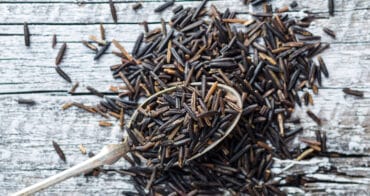
Wild rice is not technically rice but the seed of aquatic grasses. It has a nutty flavor and is commonly found in North America, particularly in regions with freshwater marshes and lakes. It is often consumed in dishes like salads, soups, and as a side dish. If foraging, wild rice grows best in gently flowing waters with a muddy or organic bottom. It prefers a water depth between six inches and three feet. Wild rice is harvested in the fall when the flower heads have ripened and turned a rich purple. Cooked wild rice has about 30% fewer calories than brown rice and 40% more protein. It gets the top spot here because of its massive typical shelf life of up to 5 years.
Rice (Oryza sativa)
Typical Shelf-life: 1-5 years
Rice is a vital staple food for billions, especially in Asia, providing essential nutrients and sustaining large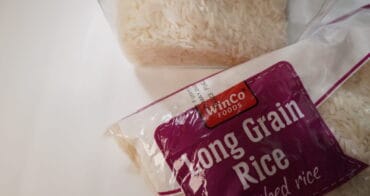 impoverished populations. Its adaptability and contribution to global food security make it one of the most crucial and widely consumed grains worldwide. You can boil or steam it, flake it, use it as flour, or even blend it into a beverage. Wild rice that topped our list is shelf stable for up to 5 years, white rice no longer than five years unless careful attention is paid to preservation and storage methods, and brown rice has the shortest shelf life compared to white rice due to its higher oil content. Brown rice contains the bran layer and germ, which are rich in natural oils and nutrients but will go rancid with oxidation and exposure to air.
impoverished populations. Its adaptability and contribution to global food security make it one of the most crucial and widely consumed grains worldwide. You can boil or steam it, flake it, use it as flour, or even blend it into a beverage. Wild rice that topped our list is shelf stable for up to 5 years, white rice no longer than five years unless careful attention is paid to preservation and storage methods, and brown rice has the shortest shelf life compared to white rice due to its higher oil content. Brown rice contains the bran layer and germ, which are rich in natural oils and nutrients but will go rancid with oxidation and exposure to air.
Quinoa (Chenopodium quinoa) – Pseudo-cereal grain
Typical Shelf-life: 2-3 years
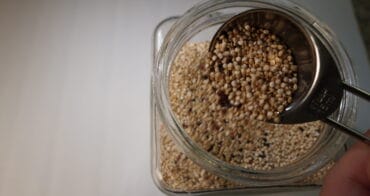 Pseudocereals are not actual cereal grains or grasses, but they produce edible seeds or fruits that are used and consumed like grains, often mistaken for conventional cereals, and are high in protein, gluten-free, and cooked similarly to grains. Quinoa is a nutrient-rich grain that originates from South America, is a complete protein source, and is naturally gluten-free. The outer shell is hard enough to allow a person to pop this like popcorn with just the heat and no oil. That will impart a nutty flavor and crunch and can liven up bland meals. That hard outer shell also provides it a 2-3 year shelf life.
Pseudocereals are not actual cereal grains or grasses, but they produce edible seeds or fruits that are used and consumed like grains, often mistaken for conventional cereals, and are high in protein, gluten-free, and cooked similarly to grains. Quinoa is a nutrient-rich grain that originates from South America, is a complete protein source, and is naturally gluten-free. The outer shell is hard enough to allow a person to pop this like popcorn with just the heat and no oil. That will impart a nutty flavor and crunch and can liven up bland meals. That hard outer shell also provides it a 2-3 year shelf life.
Chia (Salvia hispanica) – Pseudo-cereal grain
Typical Shelf-life: 2-4 years
You may have heard about Chia seeds from those Chia pets or smoothies, which are fun to grow, but it’s now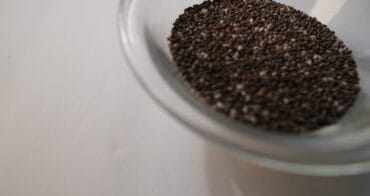 known that chia seeds are a type of superfood. The nice thing about chia seeds is they will absorb the liquid they are put in, so you can drink them easily, use them as a thickener in cooking, or sprinkle them over food for a little crunch. They contain antioxidants, minerals, fiber, and omega-3 fatty acids. These nutrients play a role in supporting multiple body functions and systems. In addition to a typical shelf-life of up to 4 years, it’s easy to sprout and grow. This grain would serve you well if you were forced to grow your food.
known that chia seeds are a type of superfood. The nice thing about chia seeds is they will absorb the liquid they are put in, so you can drink them easily, use them as a thickener in cooking, or sprinkle them over food for a little crunch. They contain antioxidants, minerals, fiber, and omega-3 fatty acids. These nutrients play a role in supporting multiple body functions and systems. In addition to a typical shelf-life of up to 4 years, it’s easy to sprout and grow. This grain would serve you well if you were forced to grow your food.
Fonio (Digitaria exilis and Digitaria iburua) – Pseudo-cereal grain
Typical Shelf-life: 1 year
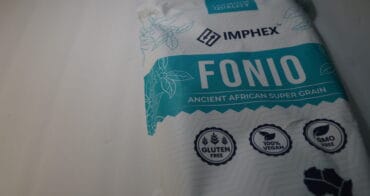 When I started researching for this video, I knew there would be grains and pseudo-cereal grains I had never heard of. Fonio is one of them. It’s a type of grass that hails mainly from West Africa. Sometimes called a superfood, fonio is nutrient-rich, gluten-free, and has a low-glycemic index making it easy to digest. It has a great nutritional value and is high in calcium, magnesium, zinc, and vitamin B. Fonio flour can be used as a substitute for other flours in many recipes. It has a nutty flavor and is used in various dishes, including porridge, salads, and side dishes.
When I started researching for this video, I knew there would be grains and pseudo-cereal grains I had never heard of. Fonio is one of them. It’s a type of grass that hails mainly from West Africa. Sometimes called a superfood, fonio is nutrient-rich, gluten-free, and has a low-glycemic index making it easy to digest. It has a great nutritional value and is high in calcium, magnesium, zinc, and vitamin B. Fonio flour can be used as a substitute for other flours in many recipes. It has a nutty flavor and is used in various dishes, including porridge, salads, and side dishes.
Teff (Eragrostis tef) – Pseudo-cereal grain
Typical Shelf-life: 1 year
Teff is one of the earliest known plants domesticated. It is the seed of an annual grass grown primarily in the Ethiopian region of Africa, where it is mainly ground into flour and used to make bread. It can also be cooked into a porridge or stew. Teff was by far the smallest grain, along with Fonio. Teff grains contain 11% protein and are an excellent source of amino acids, especially lysine, the amino acid often missing in other grains. Lysine is essential for producing proteins, hormones, enzymes, collagen, and elastin.
Ethiopian region of Africa, where it is mainly ground into flour and used to make bread. It can also be cooked into a porridge or stew. Teff was by far the smallest grain, along with Fonio. Teff grains contain 11% protein and are an excellent source of amino acids, especially lysine, the amino acid often missing in other grains. Lysine is essential for producing proteins, hormones, enzymes, collagen, and elastin.
Wheat
Typical Shelf-life: 1 year
- Freekeh (Triticum durum)
- Einkorn (Triticum monococcum)
- Emmer (Triticum dicoccum)
- Farro (Triticum dicoccum and Triticum spelta)
- Khorasan/Kamut (Triticum turanicum)
- Spelt (Triticum spelta)
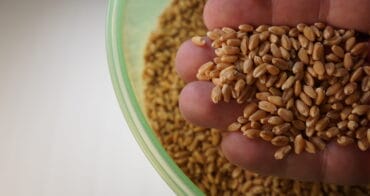 There are 20 or more wheat varieties, and about seven are cultivated extensively worldwide. I list just 6, as these are often considered closest to their unadulterated ancient forms. New wheat varieties, resulting from modern breeding efforts, typically have more rows of seeds on the wheat spike (hexaploid) due to controlled hybridization. In contrast, ancient wheat varieties, cultivated for centuries, tend to have fewer rows (tetraploid or diploid) and retain more genetic diversity. Wheat is eaten worldwide in various forms, including bread, pasta, noodles, couscous, tortillas, chapatis, porridge, and pastries. You may want to try a more ancient variety if you usually don’t process wheat well in your body. I have heard that the gluten structures are different in the ancient types, and they are typically pesticide free because they are specially grown as organic. Because of this, they may be healthier for you.
There are 20 or more wheat varieties, and about seven are cultivated extensively worldwide. I list just 6, as these are often considered closest to their unadulterated ancient forms. New wheat varieties, resulting from modern breeding efforts, typically have more rows of seeds on the wheat spike (hexaploid) due to controlled hybridization. In contrast, ancient wheat varieties, cultivated for centuries, tend to have fewer rows (tetraploid or diploid) and retain more genetic diversity. Wheat is eaten worldwide in various forms, including bread, pasta, noodles, couscous, tortillas, chapatis, porridge, and pastries. You may want to try a more ancient variety if you usually don’t process wheat well in your body. I have heard that the gluten structures are different in the ancient types, and they are typically pesticide free because they are specially grown as organic. Because of this, they may be healthier for you.
Wheat can generally be stored longer in its whole berry form compared to compacted flour when also stored in an airtight container. If you store it in berry form, you can eat them as porridge by soaking and cooking them, or you will need a mill or mortar and pestle to pound and pulverize them into flour for baking.
Freekeh is a cereal grain made from green durum wheat that is harvested young, fire-roasted, and rubbed to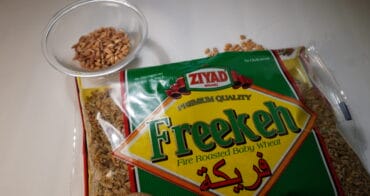 remove the skins, with its name derived from the Arabic word meaning “rubbed.” Einkorn wheat, known as “man’s first wheat,” is the oldest wheat variety with 14 chromosomes (compared to modern wheat’s 42 chromosomes), and evidence of its domestication dates back to around 10,000 years ago in southern Turkey. In the same family of ancient grains are Emmer and Farro. Kamut or Khorasan is another ancient variety that has an Egyptian name but is also called Oriental wheat. It is not widely grown, with only an estimated 16,000 acres cultivated worldwide, and does not contribute heavily to the world food supply. The grain is twice the size of modern-day wheat and has a rich, nutty flavor. And finally, Spelt is an ancient variety of wheat with a nutty flavor that has been cultivated for thousands of years. It is a good source of protein, fiber, and various nutrients.
remove the skins, with its name derived from the Arabic word meaning “rubbed.” Einkorn wheat, known as “man’s first wheat,” is the oldest wheat variety with 14 chromosomes (compared to modern wheat’s 42 chromosomes), and evidence of its domestication dates back to around 10,000 years ago in southern Turkey. In the same family of ancient grains are Emmer and Farro. Kamut or Khorasan is another ancient variety that has an Egyptian name but is also called Oriental wheat. It is not widely grown, with only an estimated 16,000 acres cultivated worldwide, and does not contribute heavily to the world food supply. The grain is twice the size of modern-day wheat and has a rich, nutty flavor. And finally, Spelt is an ancient variety of wheat with a nutty flavor that has been cultivated for thousands of years. It is a good source of protein, fiber, and various nutrients.
Job’s Tears (Coix lacryma-jobi)
Typical Shelf-life: 1 year
 This is another grain I hadn’t heard of before, but I had to give it a try. These tear-shaped grains are native to Southeast Asia but have spread to other regions, including parts of Africa and the Americas. Job’s tears are often processed and used in soups, stews, porridges, and sweet desserts. They are also sometimes ground into flour for baking or used to make beverages like tea or barley-like drinks.
This is another grain I hadn’t heard of before, but I had to give it a try. These tear-shaped grains are native to Southeast Asia but have spread to other regions, including parts of Africa and the Americas. Job’s tears are often processed and used in soups, stews, porridges, and sweet desserts. They are also sometimes ground into flour for baking or used to make beverages like tea or barley-like drinks.
Barley (Hordeum vulgare)
Typical Shelf-life: 1 year
Barley is an ancient and adaptable cereal grain widely used worldwide for thousands of years. Its diverse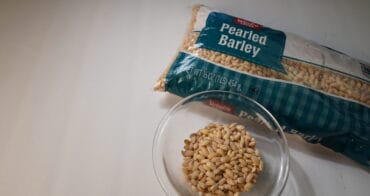 applications range from animal feed and malt production for brewing to human consumption in soups, stews, salads, and baked goods. With its rich fiber content, vitamins, and minerals, barley remains a nutritious and versatile grain choice across different cultures and cuisines. If you plan on brewing after the grid goes down, you will want Barley on hand.
applications range from animal feed and malt production for brewing to human consumption in soups, stews, salads, and baked goods. With its rich fiber content, vitamins, and minerals, barley remains a nutritious and versatile grain choice across different cultures and cuisines. If you plan on brewing after the grid goes down, you will want Barley on hand.
Amaranth (Amaranthus several species) – Pseudo-cereal grain
Typical Shelf-life: 1-2 years
Last year was my first year growing and harvesting Amaranth, and this year it popped right up again in my garden. I consider this a necessary pseudo-cereal grain in your storage because it is so easy to grow and harvest. Also, the entire plant is edible, so I often cut up some leaves for my salads. If foraging, it’s important to note that there are
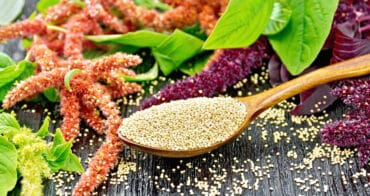
thousands of species within the Amaranthus genus, and some Amaranth species may have non-edible or even toxic parts. That’s another reason to grow your own. It can also be used as a gluten-free alternative flour. Amaranth is considered a complete protein. A complete protein contains all nine essential amino acids that the human body cannot produce independently and must obtain from the diet. While many plant-based proteins lack one or more essential amino acids, amaranth stands out as an exception. I have featured amaranth in other videos on this channel because it has both antioxidant and anti-inflammatory effects and is high in protein. We also have a more extensive breakout video on Amaranth in the works. The fact that it popped up in my garden the following year without me doing anything tells me it’s a great food to plant if you are ever forced to grow your own food.
Millet (Pennisetum glaucum)
Typical Shelf-life: 6 months to 1 year
Millet is a small-seeded ancient cereal grain widely cultivated worldwide for thousands of years. It comes in various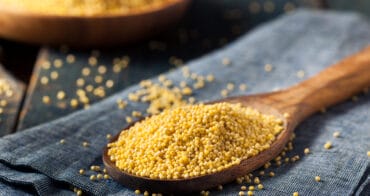 varieties, such as pearl and finger millet, and is highly nutritious, gluten-free, and easy to digest. Millet is used in diverse culinary applications, from porridges, as flour, flatbreads, and couscous-like dishes to soups and as livestock feed.
varieties, such as pearl and finger millet, and is highly nutritious, gluten-free, and easy to digest. Millet is used in diverse culinary applications, from porridges, as flour, flatbreads, and couscous-like dishes to soups and as livestock feed.
Corn (Maize) (Zea mays)
Typical Shelf-life: 6 to 12 months
Corn is a versatile cereal grain widely cultivated for culinary and industrial uses. I find corn challenging to grow without a small plot of  land because it must be planted in rows and must air pollinate. Numerous varieties exist. It comes in hundreds of different types, such as sweet, dent, flint, flour, popcorn, and waxy corn, each with distinct flavors and uses. Corn is a significant source of carbohydrates, vitamins, and minerals, and it is commonly used in foods like cornbread, tortillas, and cereals and as an ingredient in many processed products. You might want to check out our most recent recipe for fried corn mush.
land because it must be planted in rows and must air pollinate. Numerous varieties exist. It comes in hundreds of different types, such as sweet, dent, flint, flour, popcorn, and waxy corn, each with distinct flavors and uses. Corn is a significant source of carbohydrates, vitamins, and minerals, and it is commonly used in foods like cornbread, tortillas, and cereals and as an ingredient in many processed products. You might want to check out our most recent recipe for fried corn mush.
Oats (Avena sativa)
Typical Shelf-life: 6 to 12 months
Oats are another ancient grain. In its unflaked form, it is called a groat. They come in various forms, including oat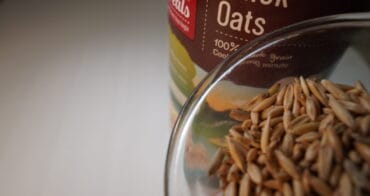 groats, rolled oats, and steel-cut oats, each offering different textures and cooking times. Oats are known for their high fiber content, protein, and essential nutrients, making them popular for breakfast cereals, porridge, baked goods, and various savory and sweet dishes. Oats are not very high-yielding for a small plot, but it’s easy to grow.
groats, rolled oats, and steel-cut oats, each offering different textures and cooking times. Oats are known for their high fiber content, protein, and essential nutrients, making them popular for breakfast cereals, porridge, baked goods, and various savory and sweet dishes. Oats are not very high-yielding for a small plot, but it’s easy to grow.
Sorghum/Jowar (Sorghum bicolor)
Typical Shelf-life: 1 year
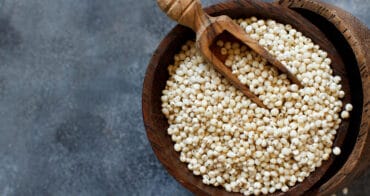 Sorghum is a resilient and versatile cereal grain cherished for its drought tolerance and abundant nutritional benefits. With distinct varieties like white, red, and black sorghum, this gluten-free grain serves as a staple food, a source of livestock and bird feed, and a raw material for crafting sorghum syrup and traditional alcoholic beverages. Packed with fiber, antioxidants, and essential nutrients, sorghum is a nourishing and adaptable choice, lending its unique touch to diverse cuisines and dietary preferences.
Sorghum is a resilient and versatile cereal grain cherished for its drought tolerance and abundant nutritional benefits. With distinct varieties like white, red, and black sorghum, this gluten-free grain serves as a staple food, a source of livestock and bird feed, and a raw material for crafting sorghum syrup and traditional alcoholic beverages. Packed with fiber, antioxidants, and essential nutrients, sorghum is a nourishing and adaptable choice, lending its unique touch to diverse cuisines and dietary preferences.
Buckwheat (Fagopyrum esculentum) – Pseudo-cereal grain
Typical Shelf-life: 1 year
Buckwheat is a hearty and nutritious pseudo-cereal grain with a distinctive nutty flavor. Despite its name, buckwheat is not related to wheat and is gluten-free. It is commonly used in various culinary creations, from traditional dishes like buckwheat pancakes and soba noodles to gluten-free baking and as a wholesome addition to salads and porridges. Buckwheat is rich in protein, fiber, vitamins, and minerals, making it a valuable and versatile grain alternative in diverse cuisines and healthy diets.
buckwheat is not related to wheat and is gluten-free. It is commonly used in various culinary creations, from traditional dishes like buckwheat pancakes and soba noodles to gluten-free baking and as a wholesome addition to salads and porridges. Buckwheat is rich in protein, fiber, vitamins, and minerals, making it a valuable and versatile grain alternative in diverse cuisines and healthy diets.
TYPICAL SHELF-LIFE
With each of these grains or pseudo-grains, I have provided you with what I call the “typical shelf-life.” Grains can become stale, rancid, or develop off-flavors once they go beyond their typical shelf-life. In some cases, grains may also be more prone to infestation by insects or mold growth as they get older. Grains that have passed their shelf life are generally still edible and safe to eat, but their quality may have deteriorated in quality, texture, nutrition, and flavor over time.
 It’s essential to store grains in a cool, dry place in airtight containers to prolong their shelf life. When grains are correctly stored, they can still be safe to eat even after their shelf life has expired, but they may lose some nutritional value and quality over time. Proper storage in cool, dry, airtight containers with oxygen absorbers can help prolong the edibility of grains years beyond their expiration date. Beyond the environmental controls of your storage, grains will last longer when they have a harder, uncracked exterior and a low internal moisture and fat content. If grains appear in good condition and show no signs of spoilage, infestation, off-odors, or mold, they may still be suitable for consumption, although they may not taste as fresh as they were within their shelf life.
It’s essential to store grains in a cool, dry place in airtight containers to prolong their shelf life. When grains are correctly stored, they can still be safe to eat even after their shelf life has expired, but they may lose some nutritional value and quality over time. Proper storage in cool, dry, airtight containers with oxygen absorbers can help prolong the edibility of grains years beyond their expiration date. Beyond the environmental controls of your storage, grains will last longer when they have a harder, uncracked exterior and a low internal moisture and fat content. If grains appear in good condition and show no signs of spoilage, infestation, off-odors, or mold, they may still be suitable for consumption, although they may not taste as fresh as they were within their shelf life.
If you’re unsure about the quality or safety of grains that have passed their shelf life, it’s best to err on the side of caution and discard them to avoid any potential health risks. When in doubt, purchasing fresh grains and following proper storage guidelines to ensure their quality and safety is better. You can take this a step further and extend shelf-life by storing it in an airtight, vacuum-sealed, temperature-stable, oxygen, moisture, and light-free environment. You can consult our food storage videos on how to do that.
—
Every one of the grains I have detailed here can be ground into flour, steamed, cooked into stews, soaked, and served on salads. Many benefit from a short cooking process to render the grain softer and break down heavy starches. I hope you will get some of these in your diet, storage, or growing in your garden. Food insecurity is often a result of no longer having options. These powerful, nutritionally-dense, ancient grains and pseudo-grains can provide you with a higher level of preparedness.
As always, stay safe out there.
Recipes:
Wild Rice
Wild Rice With Mushrooms
Rice
35 Rice Recipes
Quinoa
Quinoa Tabbouleh
Chia
Chia Fresca
Fonio
Curried Fonio
Teff
Gluten-Free Teff Crêpes
Wheat
Whole Grain Seeded Bread
Job’s Tears
Job’s Tears in Coconut Broth
Barley
Barley Oat Pancakes
Amaranth
18+ Amaranth Recipes
Millet
23 Best Ways to Cook Millet
Corn
Fried Corn Mush
Oats
Quaker’s Best Oatmeal Cookies
Sorghum/Jowar
How to Cook Sorghum
Buckwheat
Homemade Soba Noodles


I would be useful to have download link on recipes and survival guide. I ended up here trying to do those very things on YouTube
see above